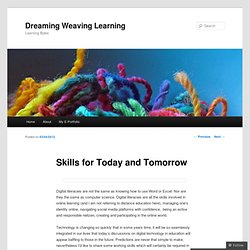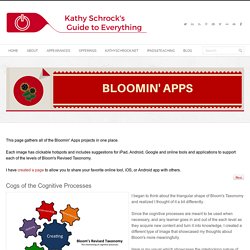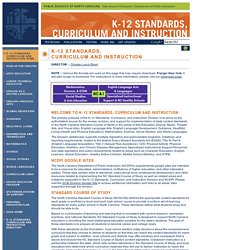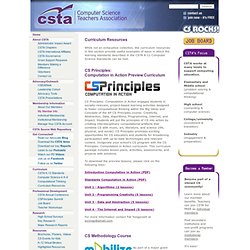

Bloom's Digital Taxonomy and Web 2 Tools by pip cleaves on Prezi. Bloom's Taxonomy - Education. Bloom's Taxonomy. University of Victoria - Counselling Services. Blooms' Taxonomy. Community.wvu.edu/~lsm018/WVSTC2011_documentation/VL4685_Classroom_to_Web/BloomPolygon.pdf. Lydia at WVU. Interactive Bloom's Taxonomy Tool. Www.in2edu.com/resources/thinking_resources/blooms_taxonomy_chart.pdf. Www.unr.edu/assess/resources/2010_Presentation_Materials/CavoteHill/Blooms_Tax_Wheel.pdf. Sasresources.wikispaces.com/file/view/Cognitive+Taxonomy+Cirlce.pdf. Online Education Technology for Teachers and Students.
Skills for Today and Tomorrow. Digital literacies are not the same as knowing how to use Word or Excel.

Nor are they the same as computer science. Digital literacies are all the skills involved in online learning (and I am not referring to distance education here), managing one’s identity online, navigating social media platforms with confidence, being an active and responsible netizen, creating and participating in the online world. Technology is changing so quickly that in some years time, it will be so seamlessly integrated in our lives that today’s discussions on digital technology in education will appear baffling to those in the future.
Predictions are never that simple to make, nevertheless I’d like to share some working skills which will certainly be required in the future – skills which already are required today: How do you ensure that today’s generation will be prepared for their tomorrows? Digital Tech & Daily Practice. My initial experience of teaching with technology was with VLEs such as BlackBoard and others.

Fortunately today we have other tools and platforms which are not so clunky and allow both teachers and students to access information more easily. As many others, I think the major change happened with Web 2.0, when all of a sudden, not only could one consume information, but now there was the opportunity to actually create one’s own space of information and knowing.
Horizons shifted and education was shaken out of passivity. Learning today is not an isolated experience when one is outside the classroom. Cuentos Interactivos. Kathy Schrock's Guide to Everything - Bloomin' Apps. This page gathers all of the Bloomin' Apps projects in one place.Each image has clickable hotspots and includes suggestions for iPad, Android, Google and online tools and applications to support each of the levels of Bloom's Revised Taxonomy.I have created a page to allow you to share your favorite online tool, iOS, or Android app with others.

Cogs of the Cognitive Processes. Freerice.com. Free History Video Lecture courses. The 21st Century Version. So much have been written about Bloom’s taxonomy; one click in a search engine will flood your page with hundreds of articles all of which revolve around this taxonomy.

Only few are those who have tried to customize it to fit in the 21st century educational paradigm. As a fan of Bloom’s pedagogy and being a classroom practitioner, I always look for new ways to improve my learning and teaching, and honestly speaking , if you are a teacher/ educator and still do not understand Bloom’s taxonomy then you are missing out on a great educational resource. The following article is a summary and a fruit of my long painstaking research in the field of Bloom’s taxonomy. The purpose is to help teachers grow professionally and provide them with a solid informational background on how to better understand and apply Bloom’s taxonomy in classrooms in the light of the new technological advances and innovations. 1 – The cognitive : The intellectual or knowledge based domain consisted of 6 levels . Analyze Literature Critically Using the SIFT Method < Teaching Channel.
Ejercicios del generador del examen ENLACE. Matemáticas primer año intermedio. Examen Interactivo de Enlace 2007-2008Sexto Grado Español, primera parte. Sallita: sala virtual educativa con juegos divertidos, actividades de aprendizaje y recursos en linea para sexto grado de primaria. TnElc. NC Standard Course of Study. The primary purpose of the K-12 Standards, Curriculum, and Instruction Division is to serve as the authoritative source for the review, revision, and support for implementation of state content standards in the North Carolina Standard Course of Study in the areas of Arts Education (Dance, Music, Theatre Arts, and Visual Arts), English Language Arts, English Language Development, Guidance, Healthful Living (Health and Physical Education), Mathematics, Science, Social Studies, and World Languages.

The North Carolina Department of Public Instruction (NCDPI)'s supplemental google sites are intended to be a resource for educators, administrators, institutions of higher education, and other interested parties. My eCoach Scope and Sequence: Basic Computer/Technology Use. ISTE NETS e-Portfolio Templates. Computer Science Teachers Association - Curriculum Resources. Curriculum Resources While not an exhaustive collection, the curriculum resources in this section provide useful examples of ways in which the learning standards described in the CSTA K-12 Computer Science Standards can be met.

CS Principles: Computation in Action Preview Curriculum CS Principles: Computation in Action engages students in socially-relevant, project-based learning activities designed to foster computational thinking within the Big Ideas and Concepts of the AP CS Principles course: Creativity, Abstraction, Data, Algorithms, Programming, Internet, and Impact. TDOE. North Carolina Public Schools.